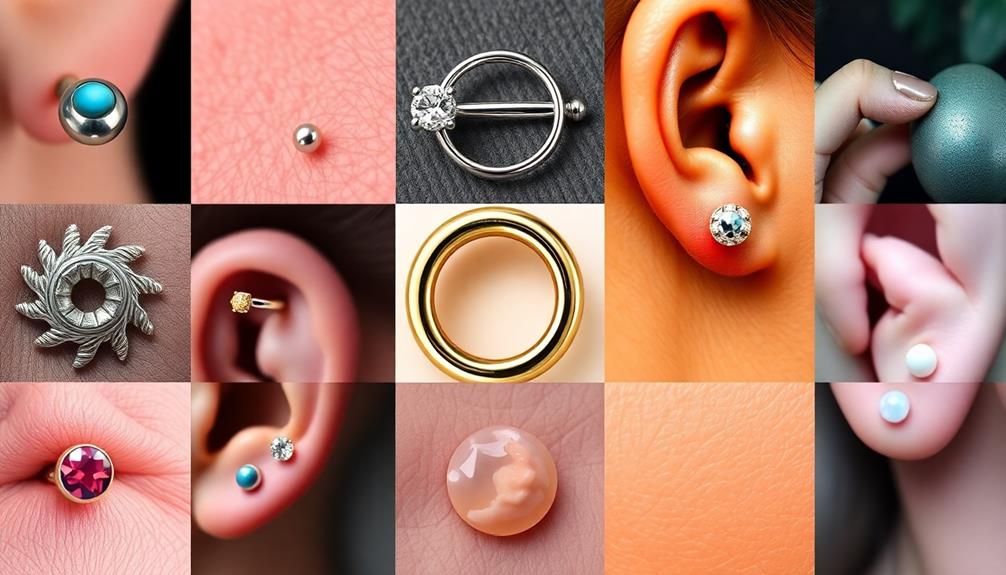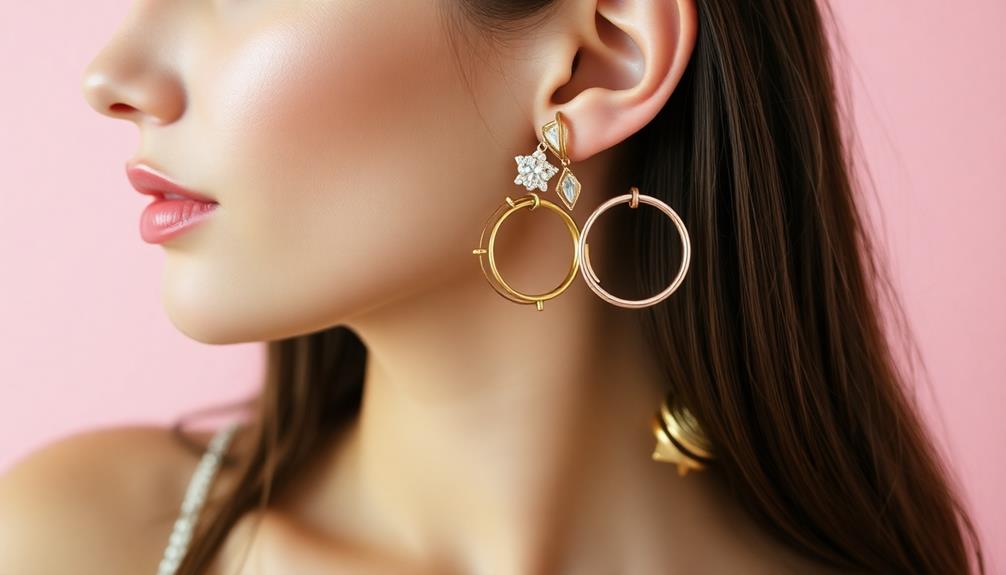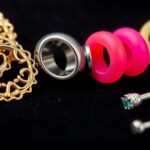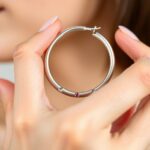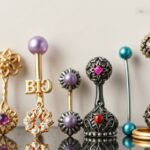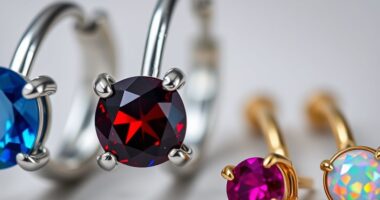When choosing piercing jewelry, consider your skin type. Titanium is hypoallergenic, lightweight, and great for initial piercings. Gold can be luxurious but make sure it's nickel-free. Surgical stainless steel is common but may irritate sensitive skin due to trace nickel. For artistic flair, niobium offers safe colors, while acrylic and silicone are budget-friendly but unsuitable for long-term wear due to potential irritation. Always opt for high-quality materials to minimize skin reactions. Stay informed on how different materials affect your skin, and you'll find the best fit for your unique needs. There's more valuable insight ahead!
Key Takeaways
- Titanium is hypoallergenic and ideal for initial piercings, promoting healing and reducing irritation risks for sensitive skin.
- Gold (14k & 18k) is luxurious and durable, but ensure it is nickel-free to avoid allergic reactions in healed piercings.
- Surgical stainless steel is affordable but may contain trace nickel, which can irritate those with sensitive skin.
- Niobium is completely hypoallergenic and safe for sensitive skin, available in various colors for personalized style.
- Acrylic and silicone jewelry can cause irritation and are unsuitable for healing piercings; prioritize biocompatible materials for safety.
Overview of Piercing Jewelry Materials
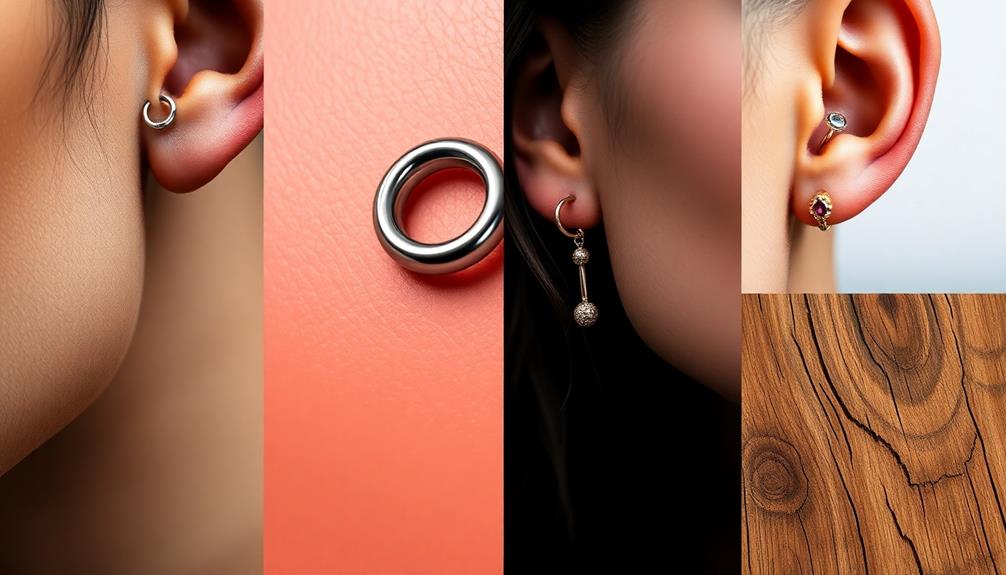
When it comes to choosing piercing jewelry materials, understanding your options is essential for both comfort and safety.
Titanium is a top choice for initial body piercings due to its hypoallergenic properties and minimal nickel content, which promotes easier healing and reduces irritation risks.
If you're considering something for healed piercings, 14k and 18k Gold are excellent options—just make sure it's solid gold to avoid potential allergic reactions from plated materials.
Surgical Stainless Steel, specifically 316L or 316LVM, is another affordable and commonly used option, but be cautious as it may contain trace amounts of nickel that can irritate sensitive skin types.
For those with metal sensitivities, niobium is a safe, hypoallergenic alternative to titanium, and it comes in various colors to suit your style.
Lastly, while bioplast and organic materials can be appealing for temporary wear, they should be avoided for initial piercings.
These materials can harbor bacteria and complicate healing, making it important to prioritize biocompatible options for your body piercings.
Acrylic Jewelry: Pros and Cons

Acrylic jewelry offers a vibrant splash of color and creativity, making it a popular choice for those looking to express their personal style on a budget. Its affordability and wide variety of designs attract budget-conscious individuals.
However, while acrylic is lightweight and comfortable, it comes with some drawbacks. One major con is its fragility; acrylic is prone to scratches and cracks, which can lead to irritation or even injury. This fragility means it may not withstand daily wear, making it better suited for temporary use rather than long-term adornments.
Additionally, if you have sensitive skin, acrylic mightn't be your best option, as it can cause irritation over time.
Another critical consideration is the infection risk. Acrylic jewelry isn't suitable for healing piercings since it can't be autoclaved, making it a potential breeding ground for bacteria. If you're looking for something to wear while your piercings heal, it's wise to choose materials that are safe and hygienic.
Silicone Jewelry: Benefits and Drawbacks
Silicone jewelry has emerged as a popular alternative for those seeking comfort and versatility in their accessories. It's biocompatible and flexible, making it an excellent choice for individuals with allergies to metals. However, it's important to wear silicone jewelry only temporarily. Prolonged use can lead to risks such as auto-stretching and tearing.
| Benefits | Drawbacks |
|---|---|
| Lightweight and comfortable | Not suitable for long-term wear |
| Wide range of colors and designs | Can harbor bacteria due to porous nature |
| Easier to clean than metals | May cause irritation if not maintained |
| Flexible material | Can lead to infection if suction blocks healing |
While silicone jewelry is easy to maintain, diligent cleaning is necessary to prevent irritation and infection. The porous nature of silicone means it can trap bacteria, increasing the chances of complications, especially if you don't clean it regularly. Despite its appeal, silicone lacks the aesthetic longevity of materials like titanium or gold, making it more suited for temporary wear. Consider these factors carefully before choosing silicone jewelry for your piercings.
Bioplast: Healing and Hygiene Concerns
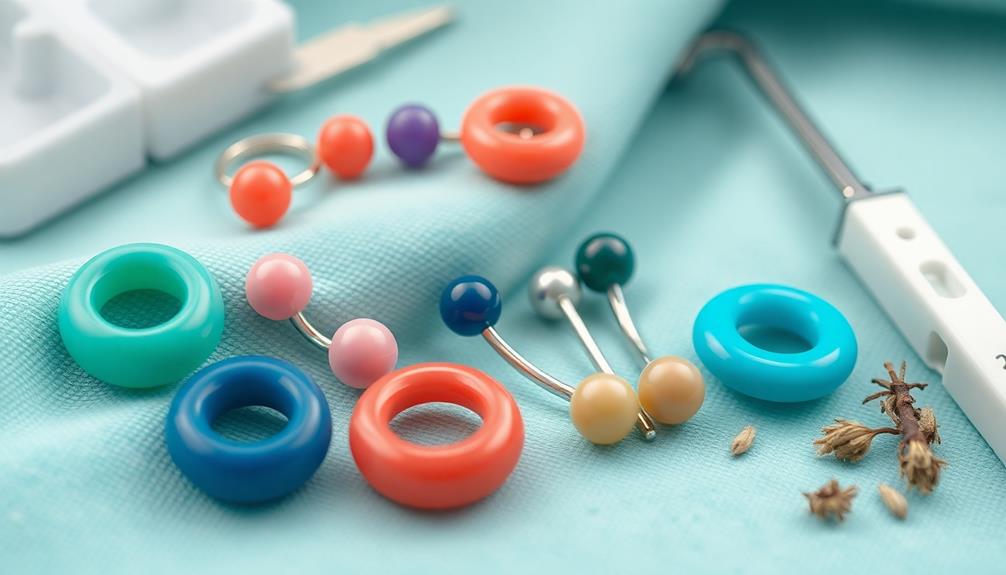
Bioplast jewelry is often recommended for healing piercings due to its hypoallergenic and biocompatible properties. This makes it a safe choice for most skin types during the initial healing phase.
However, while bioplast can be sterilized, it's not meant for long-term wear. Over time, scratches may develop, potentially harboring bacteria that lead to infections.
To guarantee proper hygiene, you should keep your bioplast jewelry clean and free from debris. Its flexible nature can create suction, which might block natural seepage and result in complications if not maintained properly.
Regular checks for any signs of skin irritation or infection are important, especially for those with sensitive skin or allergies to certain plastics.
You also need to monitor your jewelry for scratches or damage, as these imperfections can increase the risk of bacterial growth and complicate the healing process.
Metal Options for Piercings
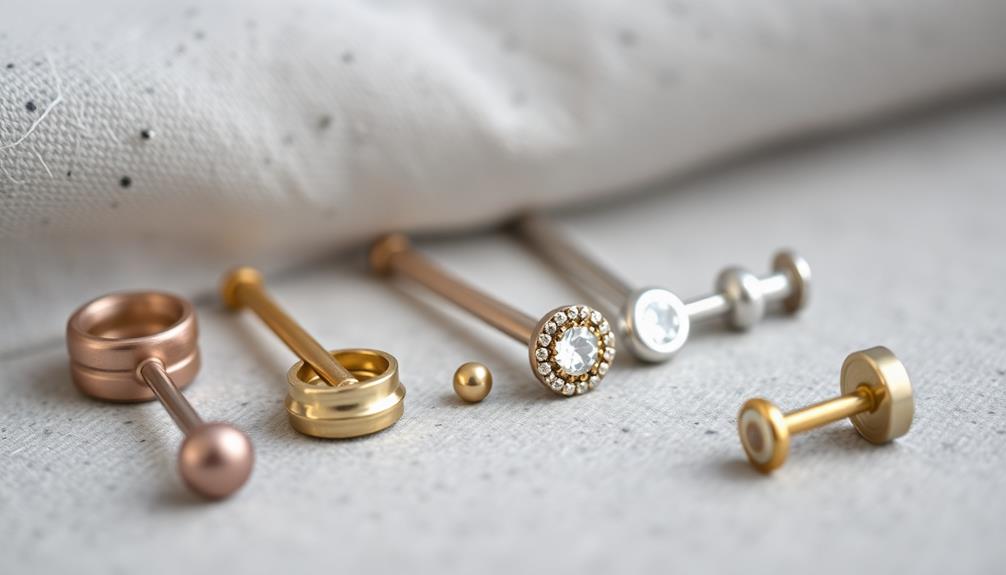
When choosing metal for your piercings, it's essential to take into account options like titanium, gold alloys, and stainless steel.
Each material has its benefits, from titanium's hypoallergenic properties to gold's luxurious appeal, but they also come with their own drawbacks.
Understanding these factors will help you make the best choice for your skin and lifestyle.
Titanium Benefits and Drawbacks
Titanium offers numerous benefits for piercing jewelry, particularly for those with sensitive skin or metal allergies. Specifically, implant-grade titanium (ASTM F136) is highly hypoallergenic, making it a top choice during the initial healing phase.
Its corrosion resistance and lightweight nature contribute to comfort, helping to reduce irritation and promoting a smoother healing process.
You'll also appreciate titanium's versatility with respect to personalization. The metal can be anodized in various colors, allowing you to express your style without sacrificing safety or skin compatibility.
Plus, it remains affordable, with prices typically ranging from $15 to $40 for quality pieces, making it accessible for most budgets.
While titanium is generally safe for long-term wear, it's wise to keep an eye on any potential skin reactions. Everyone's body chemistry is unique, and even hypoallergenic materials can occasionally cause varying responses.
By choosing titanium, you're opting for a material that balances comfort, style, and practicality, especially if you have sensitive skin or allergies.
Gold Alloys Explained
For those exploring options beyond titanium, gold alloys present an appealing choice for piercing jewelry. Typically available in 14k and 18k options, these alloys combine gold with other metals for enhanced durability.
With 14k gold containing 58.3% pure gold and 18k gold containing 75%, they're more resilient than solid gold, which is softer and can be prone to scratches.
If you have sensitive skin, opt for nickel-free gold alloys. Nickel is a common allergen that can trigger skin irritation or allergic reactions, making it vital for those with sensitivities to choose wisely.
While 14k and 18k gold are generally considered hypoallergenic, the presence of other metals in the alloy may still cause reactions in some individuals.
When selecting body jewelry, steer clear of gold-plated options for new piercings. Solid gold is less likely to flake, exposing reactive underlying metals.
Stainless Steel Considerations
While exploring piercing options, stainless steel often stands out due to its affordability and hypoallergenic properties.
Particularly, 316L stainless steel, a type of surgical steel, is widely used for body jewelry. It's crucial to take into account a few key factors when choosing this material for your piercings:
Additionally, some essential oils, like lavender oil, can have calming effects that may help ease skin irritation during the healing process, making them a beneficial complement to your aftercare routine for new piercings essential oils for calming effects.
- Nickel Allergies: Stainless steel contains trace amounts of nickel, which can irritate individuals with nickel allergies.
- Implant Grade Standards: Verify the stainless steel jewelry meets implant-grade standards to minimize allergic reactions, especially for sensitive skin types.
- Corrosion Resistance: 316L stainless steel is corrosion resistant, making it a durable choice for piercings that require regular exposure to moisture.
- Maintenance: Regular cleaning and monitoring for signs of irritation can help prevent allergic reactions and guarantee your jewelry remains safe and comfortable.
For those seeking alternatives, implant grade titanium is another hypoallergenic option.
While stainless steel works well for many, always prioritize your skin's needs and consult a professional if you have concerns about potential allergic reactions.
Safe Metals for Sensitive Skin
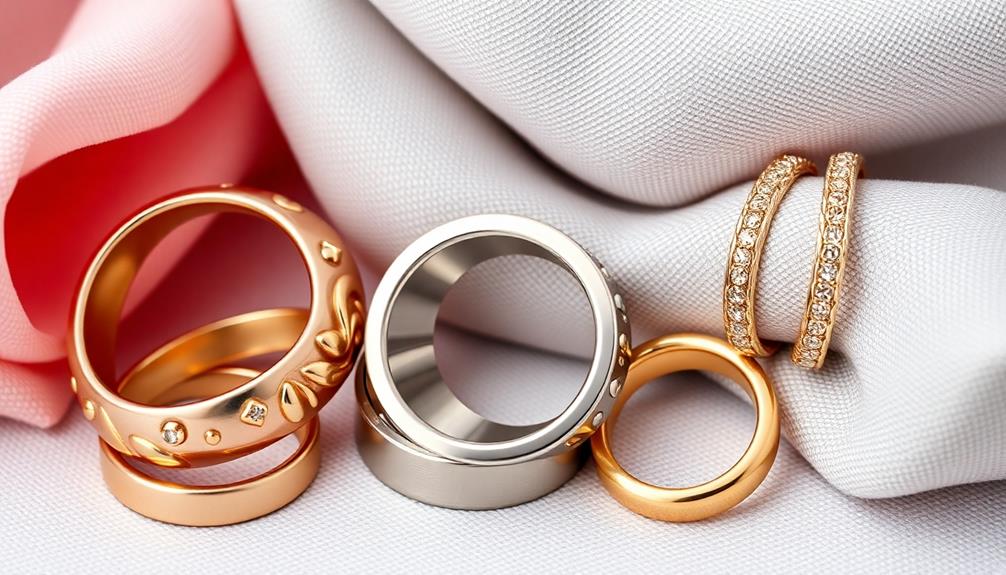
When it comes to choosing jewelry for sensitive skin, selecting hypoallergenic metals is essential to avoid irritation.
You'll want to reflect on options like titanium, niobium, and nickel-free gold, which are known for their compatibility with delicate skin.
Understanding how different materials affect your skin can make all the difference in your piercing experience.
Hypoallergenic Metal Options
Choosing the right metal for your piercing is vital, especially if you have sensitive skin. Opting for hypoallergenic metal can make a significant difference in your comfort and overall experience. Here are some excellent options to take into account:
- Titanium: This implant-grade metal is known for its hypoallergenic properties and minimal nickel content, making it ideal for sensitive skin and initial piercings.
- Niobium: Completely hypoallergenic and non-reactive, niobium is a biocompatible metal that offers a safe alternative for individuals with metal sensitivities. Plus, it comes in various colors for customization.
- Platinum: As a completely hypoallergenic metal, platinum is a safe choice for sensitive skin. Keep in mind, though, that it may be heavier and more expensive than other options.
- Nickel-Free Gold: 14K and 18K gold provide excellent inert qualities, but make sure they're nickel-free to avoid allergic reactions.
While surgical stainless steel is commonly used, be cautious of trace nickel content, which can irritate sensitive skin.
Choosing the right body jewelry material is essential for a positive piercing experience.
Skin Reaction Considerations
Understanding how your skin reacts to different materials is key for a successful piercing experience. If you have sensitive skin, it's essential to choose the right jewelry to minimize the risk of allergic reactions.
Implant-grade titanium is an excellent option; it's hypoallergenic, lightweight, and corrosion-resistant, making it perfect for healing piercings.
While surgical stainless steel, particularly 316L grade, is commonly used, be cautious if you have nickel sensitivities, as it contains trace amounts of nickel.
Niobium, another biocompatible choice, is also hypoallergenic and comes in various colors, allowing for personal expression without irritation.
Solid 14k and 18k gold can be safe for initial piercings too, but make sure they're nickel-free to avoid potential allergic reactions.
On the other hand, steer clear of materials like acrylic and silicone, as they can irritate and lead to infections, especially in fresh piercings.
Common Reactions to Jewelry Materials
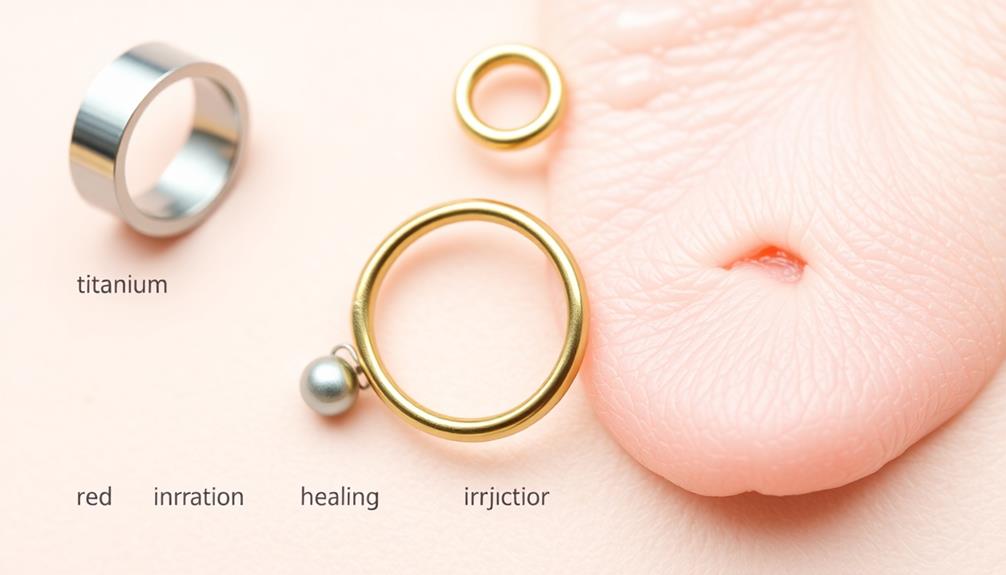
Many people with sensitive skin can experience unwanted reactions to various jewelry materials. If you're prone to irritation, it's crucial to understand the potential risks associated with different metal types. Here are some common reactions you might encounter:
- Skin discoloration: Low-quality body jewelry may cause noticeable changes in your skin's color.
- Dryness: Certain metals, particularly those containing nickel, can lead to excessive dryness and flaking.
- Soreness: You might feel discomfort or pain where the jewelry contacts your skin, especially if it's not hypoallergenic.
- Contact dermatitis: This allergic reaction can manifest as redness, swelling, and itching, often appearing within 24 hours of exposure.
To minimize these issues, opt for biocompatible materials like implant-grade titanium or niobium, which are hypoallergenic and contain minimal nickel.
Regularly monitor your skin for signs of irritation, and consider patch testing if you suspect a metal allergy. Early detection of skin reactions can help you avoid severe allergic reactions and complications, ensuring a more comfortable experience with your body jewelry.
Importance of Quality Sources
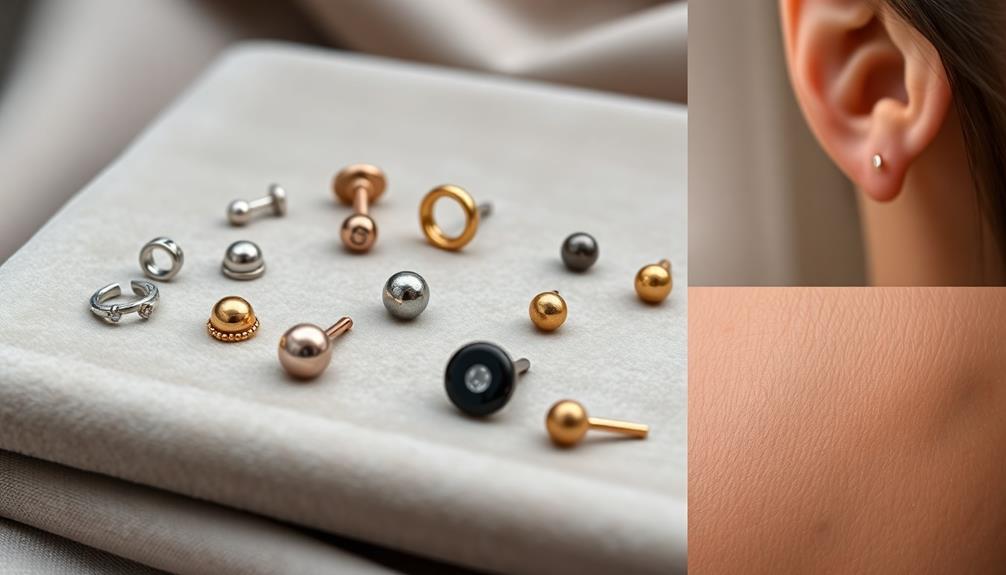
When it comes to body jewelry, the quality of materials you select plays a considerable role in minimizing skin reactions and ensuring a safe experience. Choosing high-quality options like implant-grade titanium and surgical stainless steel can greatly reduce the risk of allergic reactions, especially for sensitive skin types. The Association of Professional Piercers (APP) emphasizes sourcing jewelry from reputable suppliers who prioritize biocompatibility and adhere to safety standards.
Here's a quick reference table to help you understand the importance of material quality:
| Material | Pros |
|---|---|
| Implant-Grade Titanium | Lightweight, biocompatible, durable |
| Surgical Stainless Steel | Corrosion-resistant, affordable |
| Gold (14k or higher) | Hypoallergenic, aesthetic appeal |
| Niobium | Hypoallergenic, customizable colors |
| Acrylic | Lightweight, budget-friendly |
Research on Skin Reactions

Research on skin reactions to body jewelry reveals that individual body chemistry plays an essential role in how your skin responds to different materials.
While some options are marketed as hypoallergenic, your unique sensitivity may still provoke reactions. Understanding these reactions is important for your well-being, especially when reflecting on how certain materials can manipulate your body's response, similar to how gaslighting tactics affect emotional stability.
Here are four key points to reflect on:
- Nickel Sensitivity: Many people experience allergic reactions to nickel, often used in lower-grade metals. This can cause discomfort and irritation.
- Patch Testing: If you're concerned about metal allergies, think about patch testing. This can help identify your specific reactions to various materials, ensuring you avoid severe responses.
- Material Quality: Non-sterile or reactive materials can lead to infections or irritations. Always opt for high-quality jewelry, especially for new piercings.
- Recommended Metals: For sensitive skin, materials like titanium or niobium are often recommended. These metals are less likely to cause adverse reactions compared to other options.
Frequently Asked Questions
What Is the Best Material for Piercings on Sensitive Skin?
If you have sensitive skin, opt for titanium or niobium, as they're hypoallergenic. Surgical stainless steel can work if it's implant grade, but verify any gold is nickel-free to minimize irritation and reactions.
What Material Should My Piercings Be?
You might think all jewelry's the same, but it's not! For your piercings, choose titanium or niobium for initial ones; later, opt for nickel-free gold. Always prioritize hypoallergenic materials to avoid irritation and guarantee comfort.
What Types of Jewelry Should Be Avoided When Considering a Piercing?
You should avoid acrylic, silicone, organic materials, low-quality metals, and plated jewelry for piercings. These materials can lead to infections, allergic reactions, or complications, hindering your healing process and overall comfort during this experience.
What Piercing Material Is Hypoallergenic?
Choosing hypoallergenic materials for your piercings is like finding a shield in a battle. Titanium and niobium are excellent choices, as they resist irritation, ensuring your skin remains calm and free from allergic reactions.
Conclusion
When choosing piercing jewelry, it's crucial to take into account your skin type and material preferences. Did you know that about 20% of people experience allergic reactions to certain metals? By opting for hypoallergenic options like titanium or bioplast, you can greatly reduce the risk of irritation. Remember, investing in quality materials not only enhances your comfort but also promotes healing. Ultimately, understanding your skin's needs will lead to a more enjoyable piercing experience.

